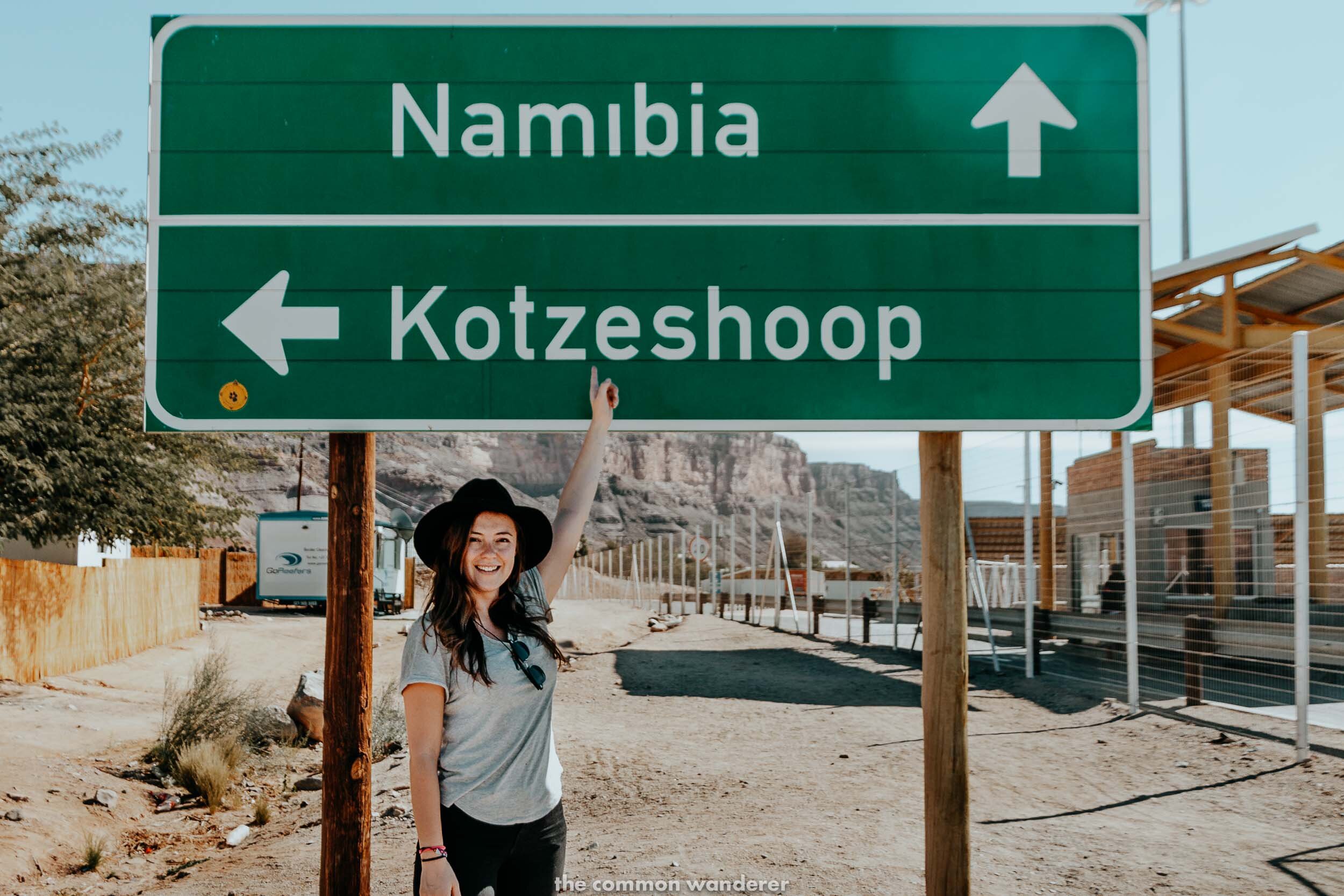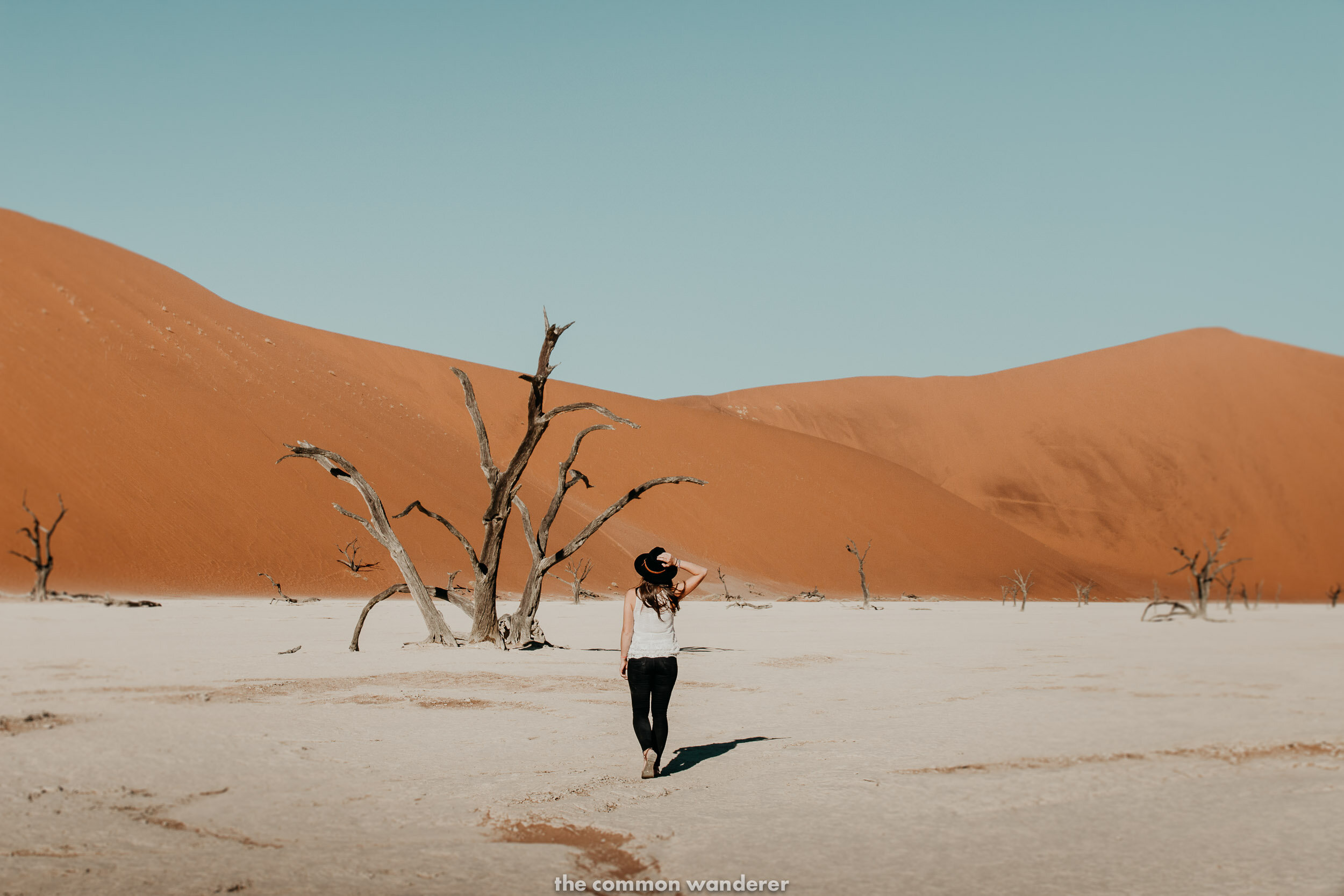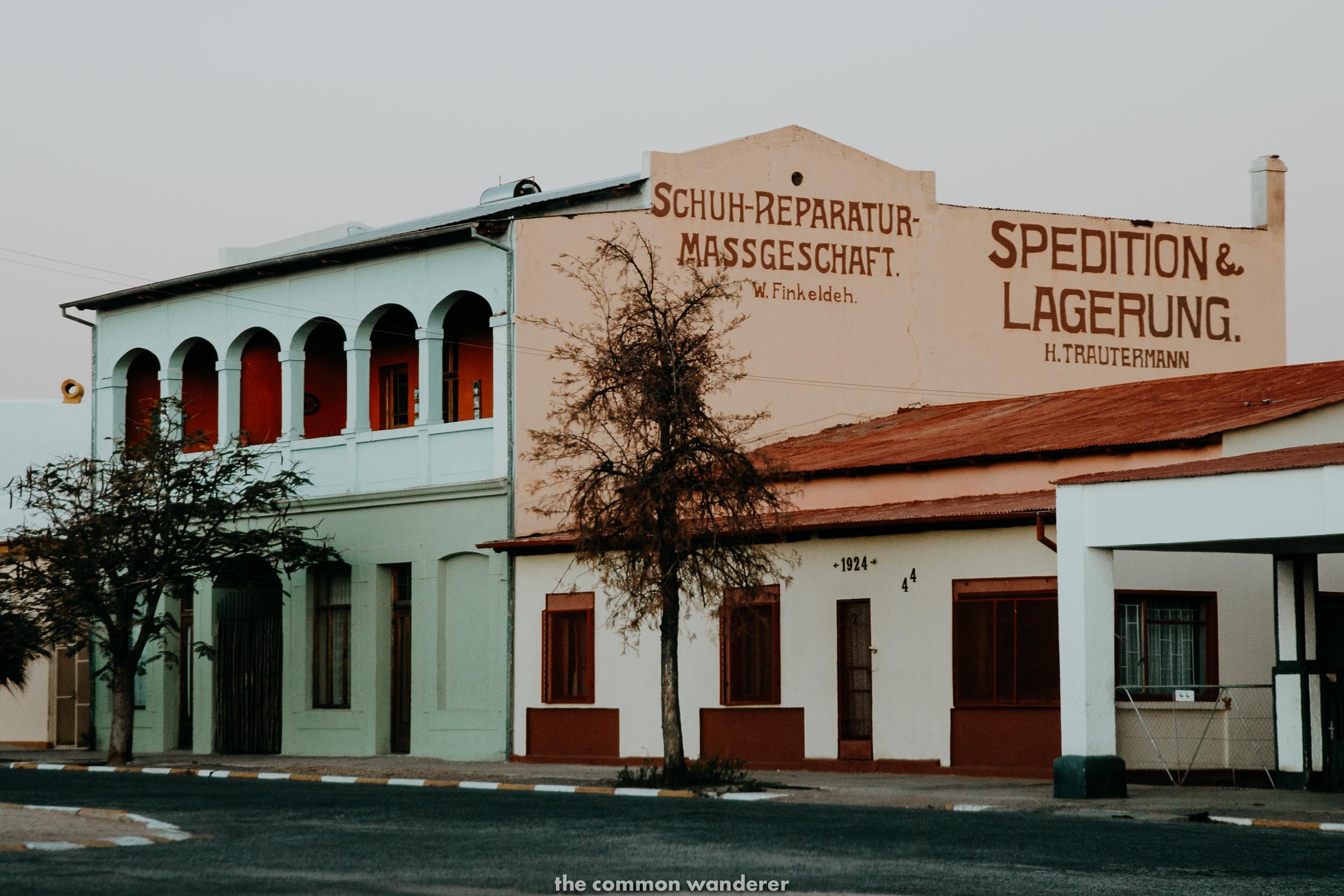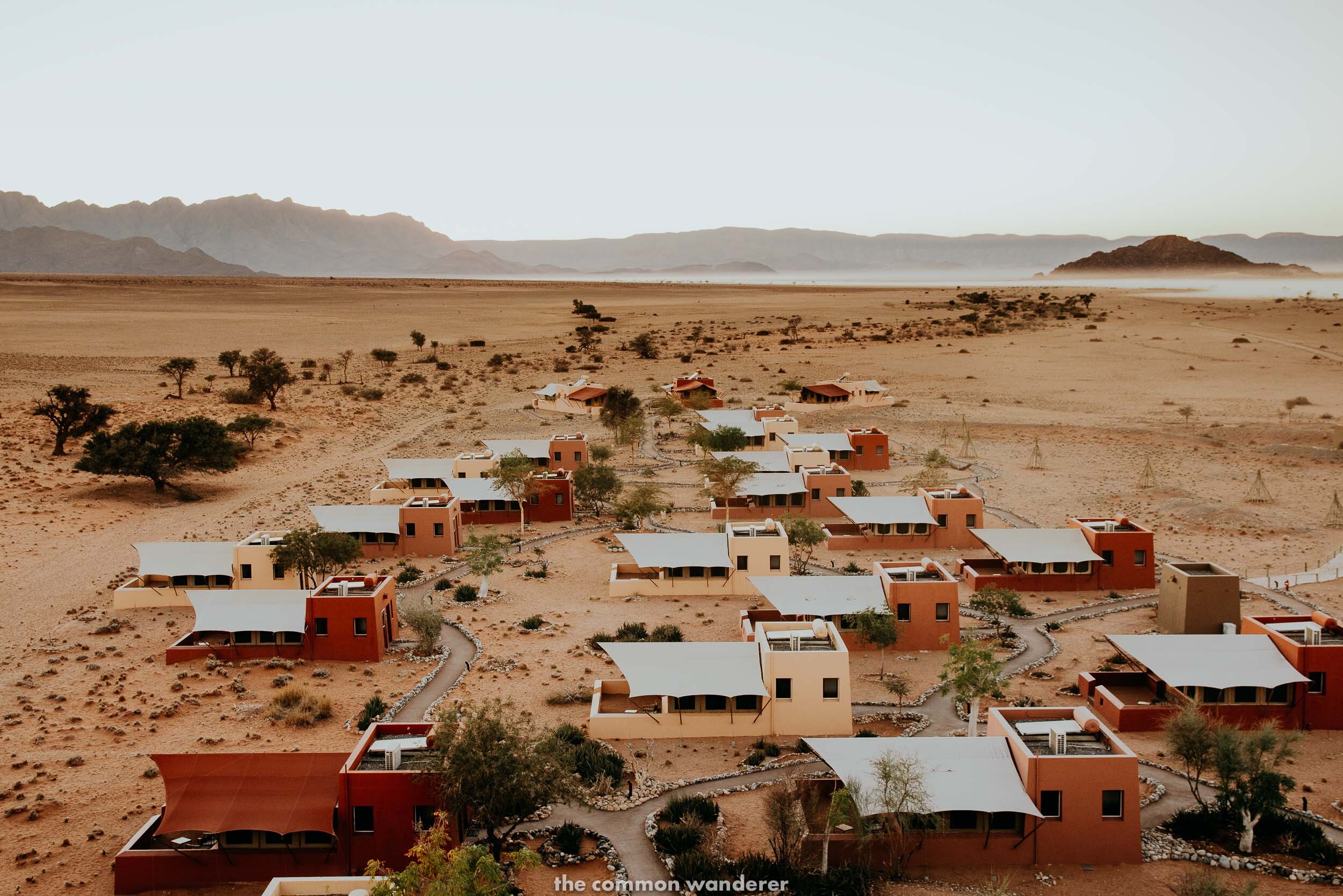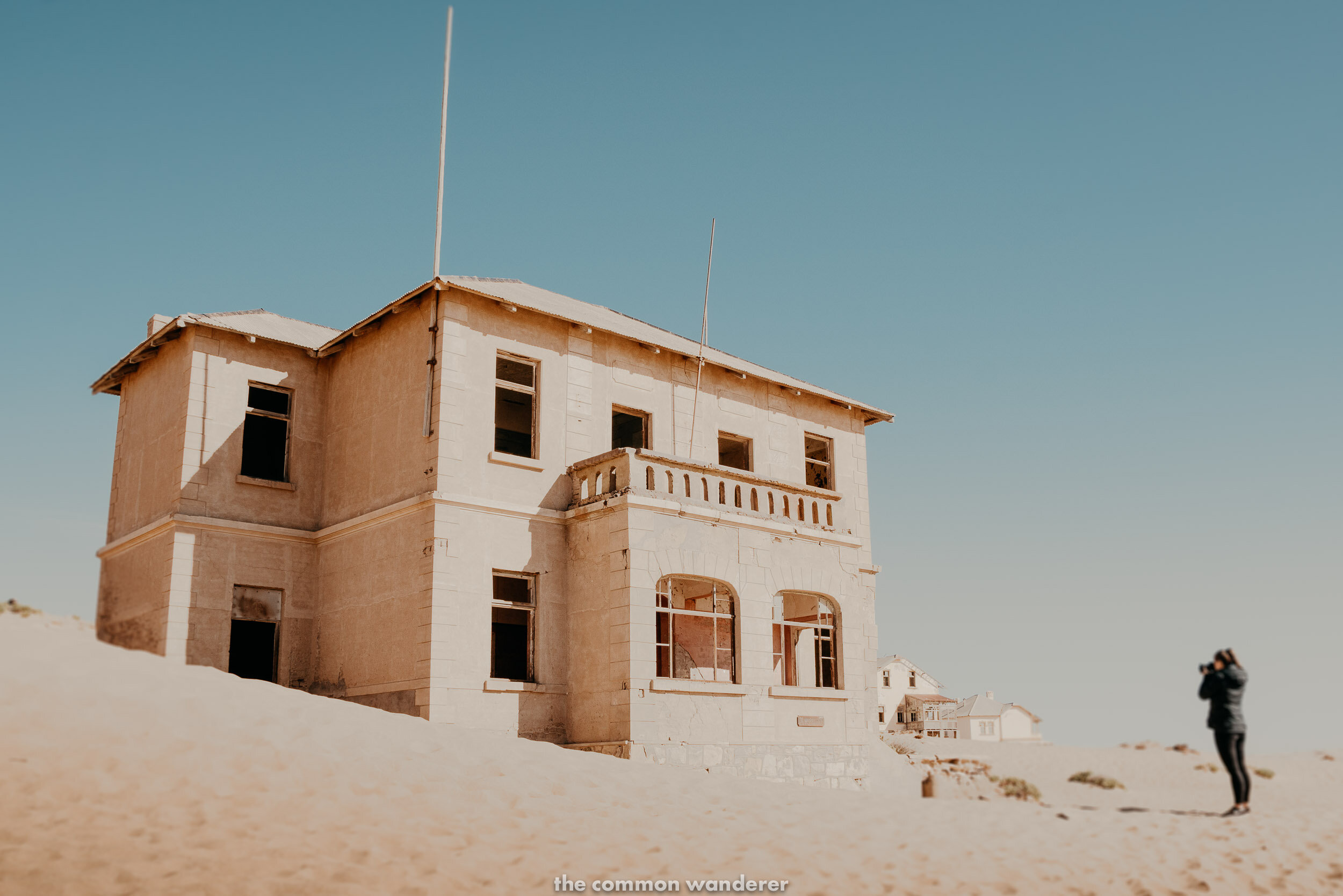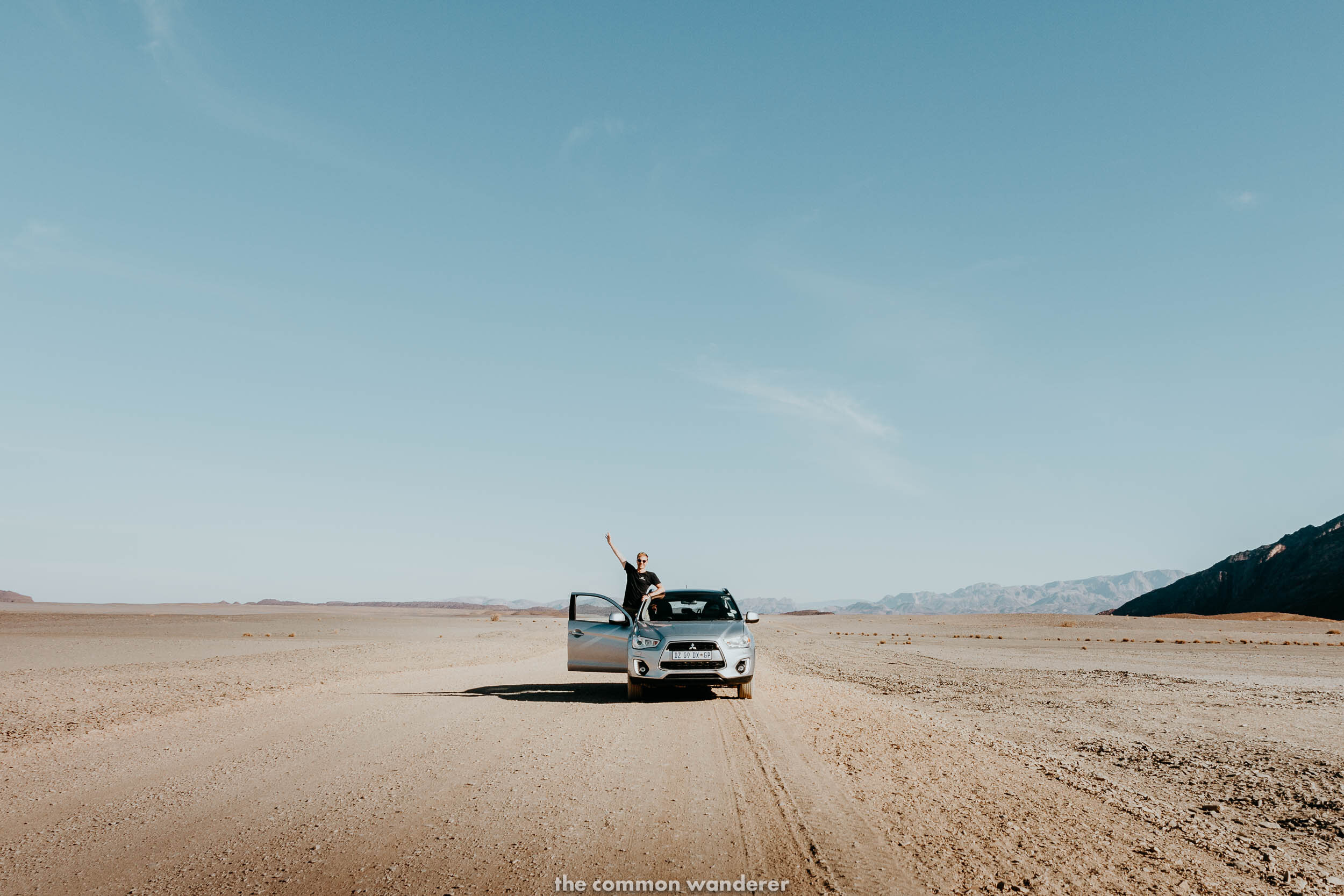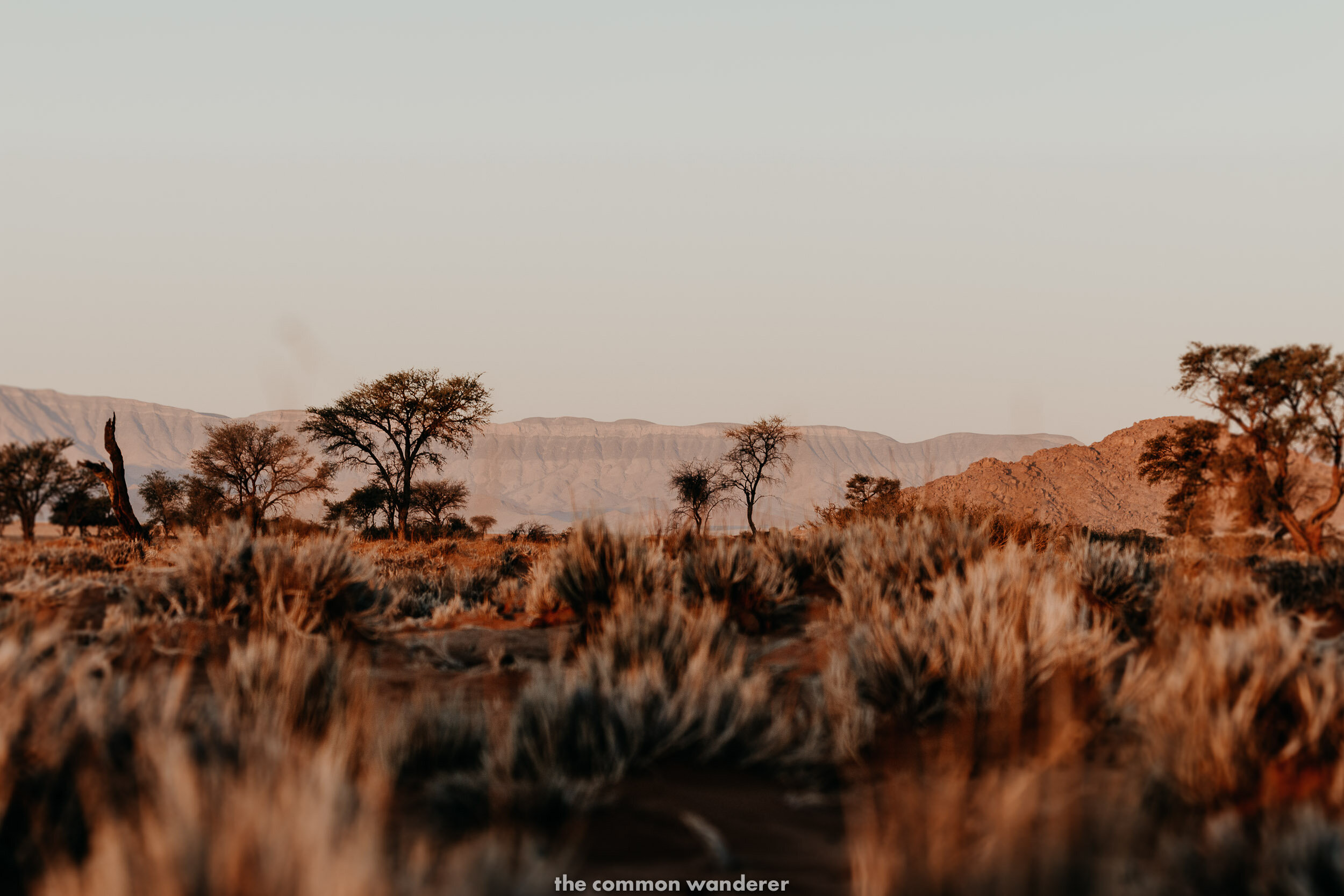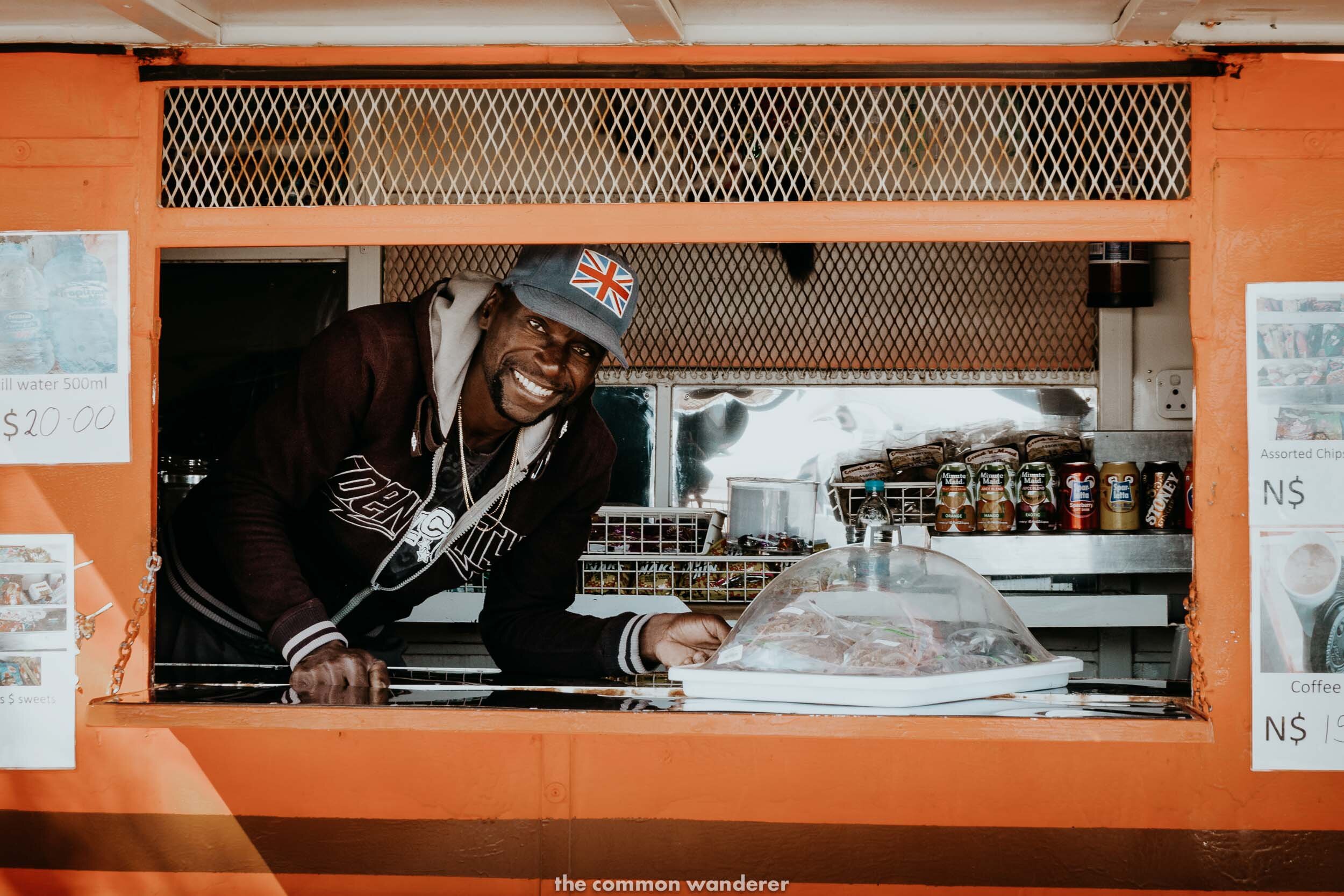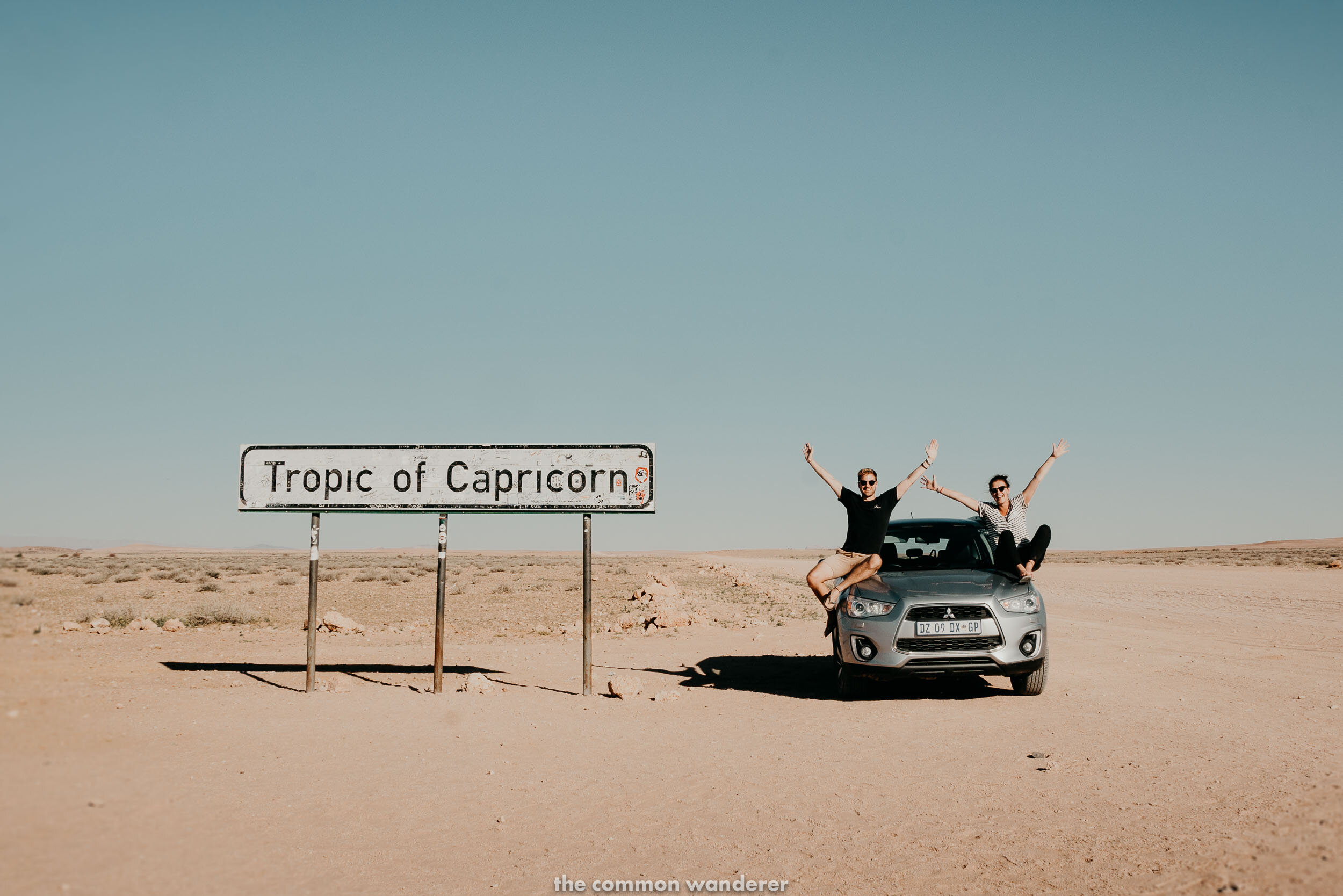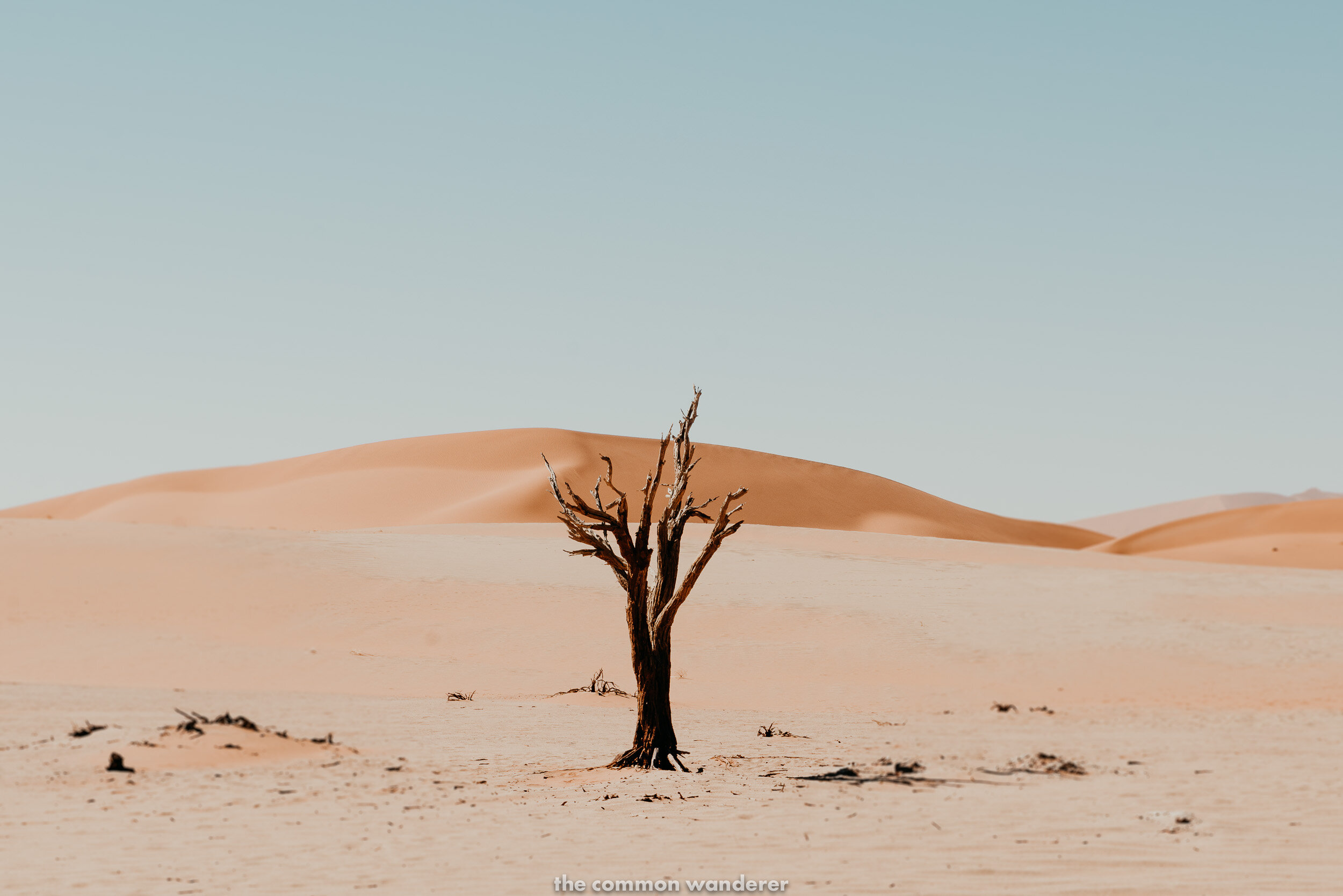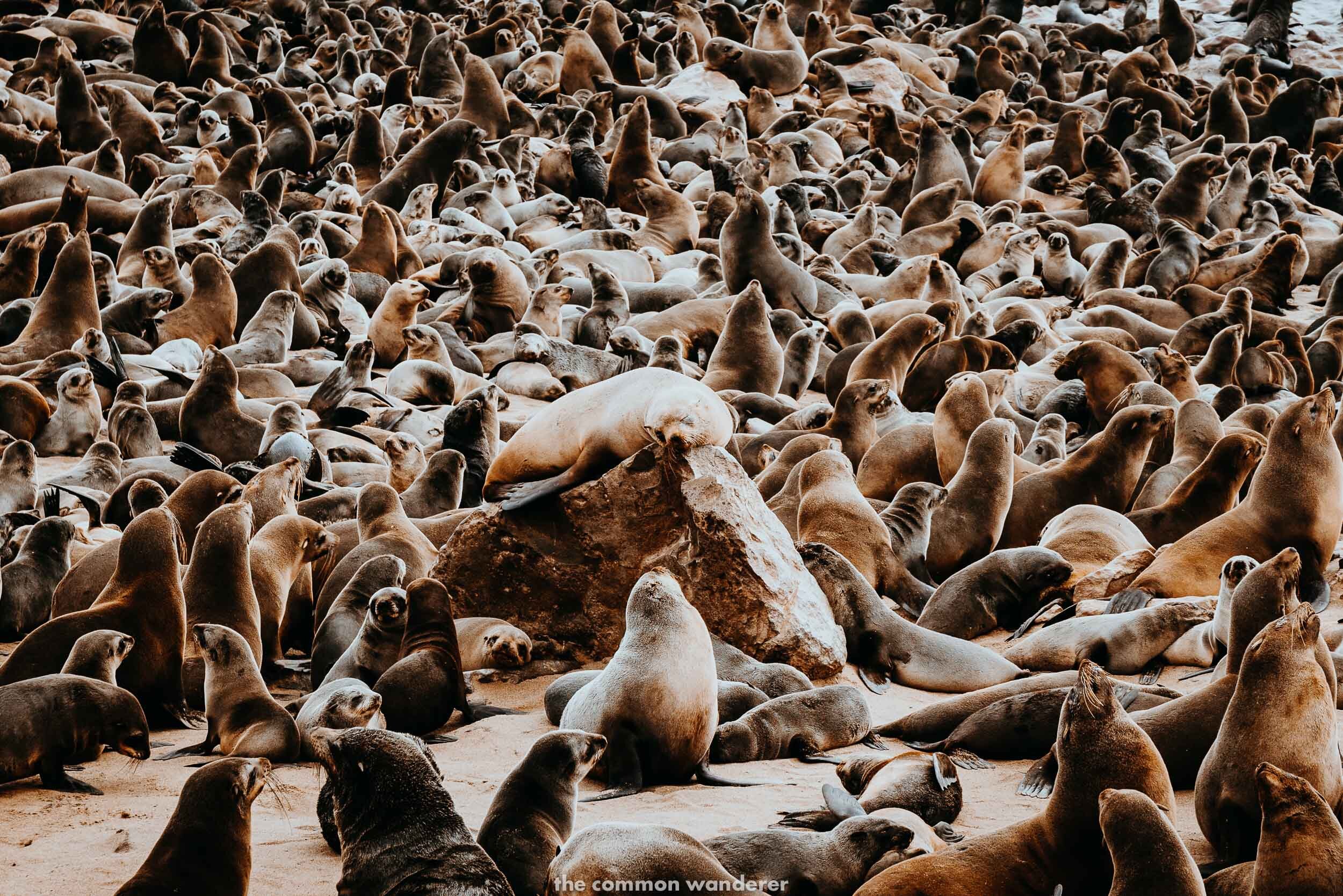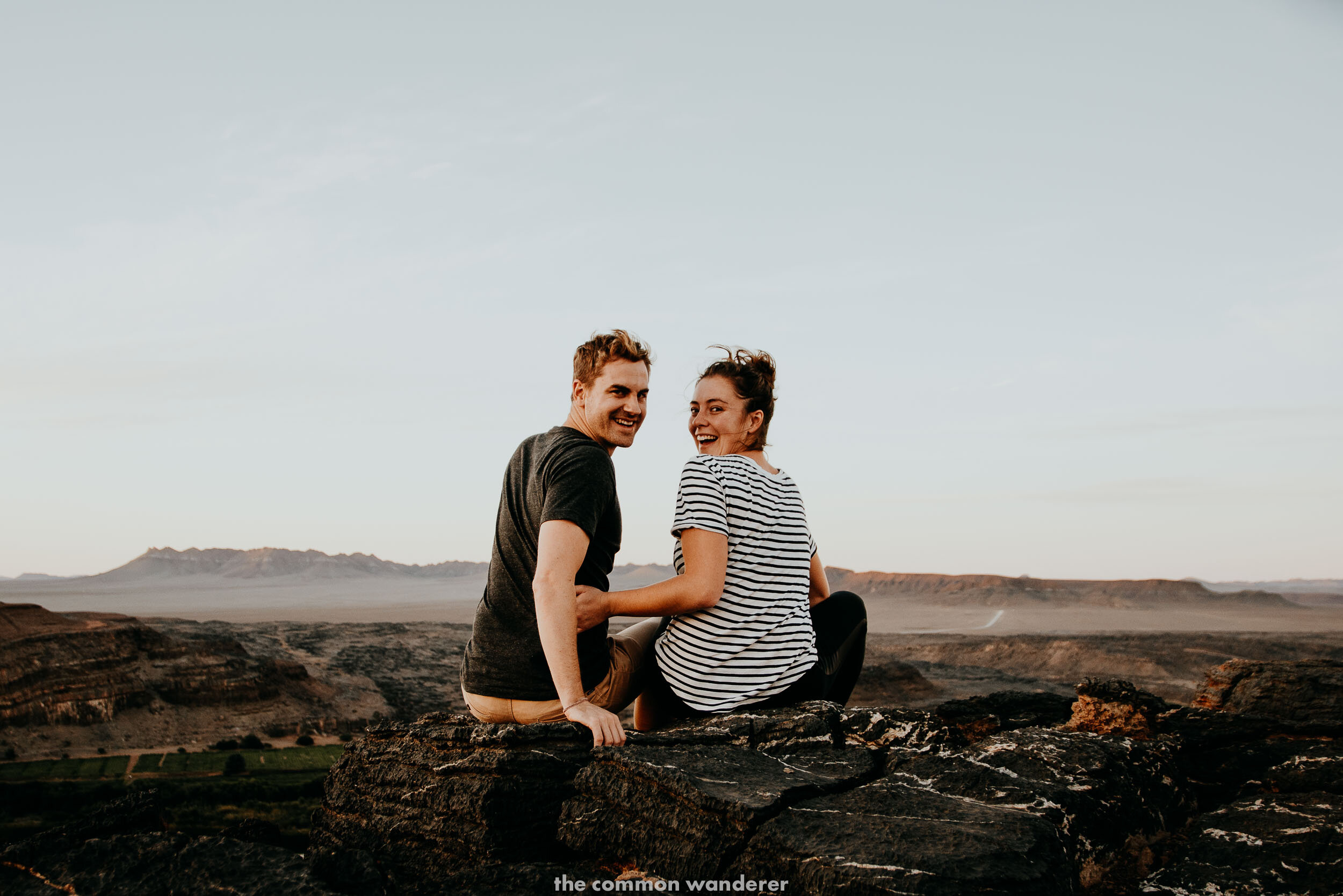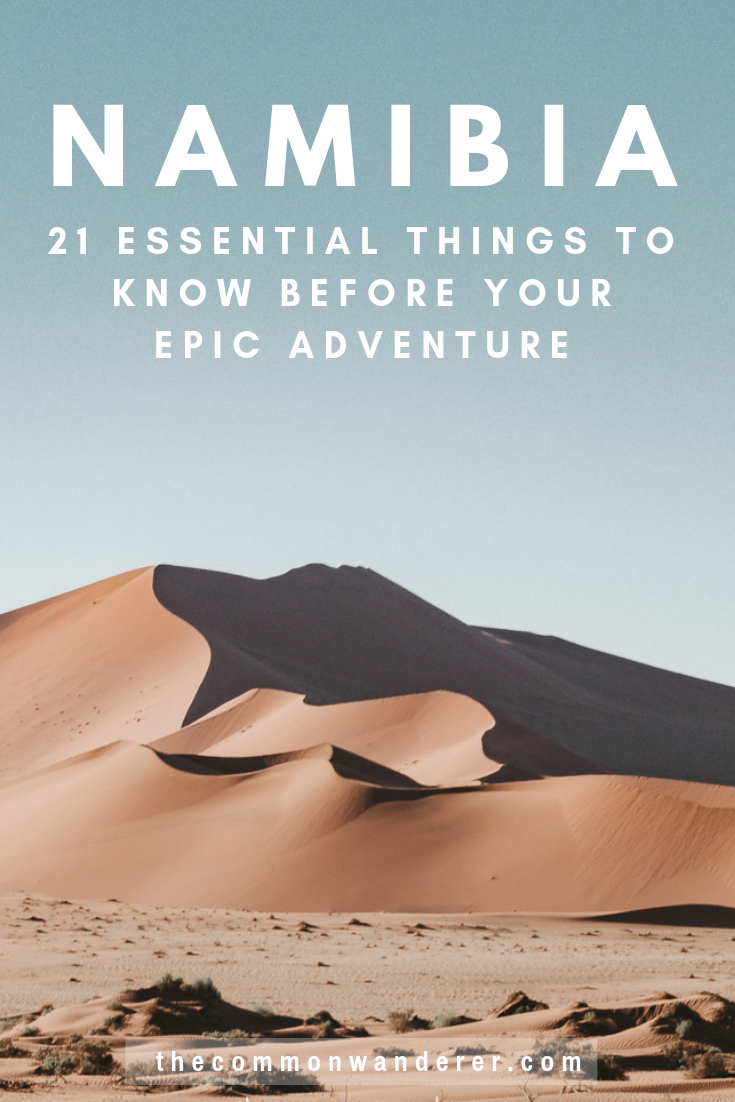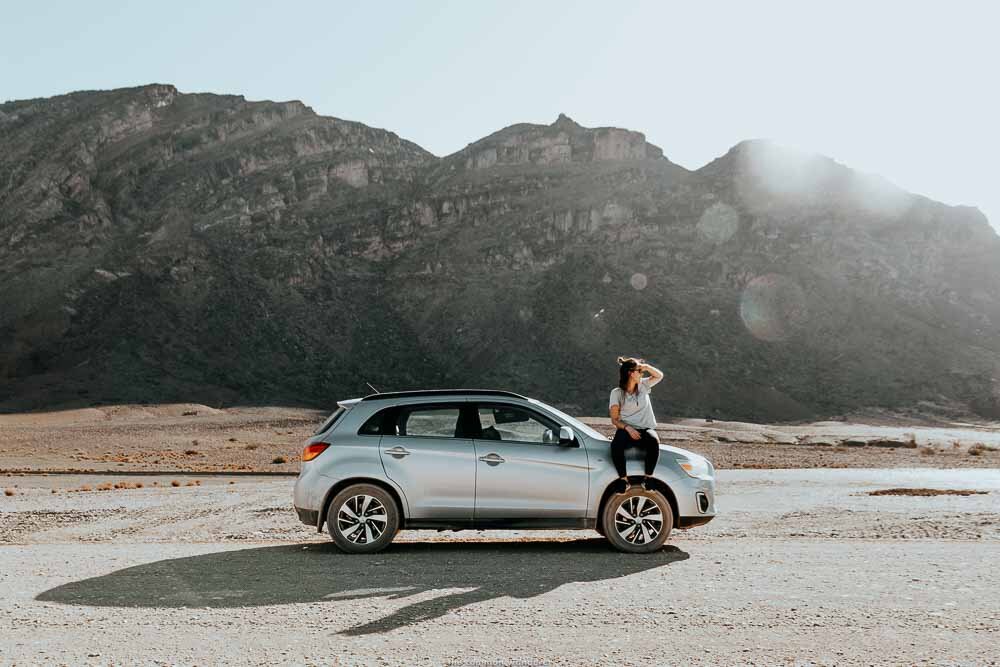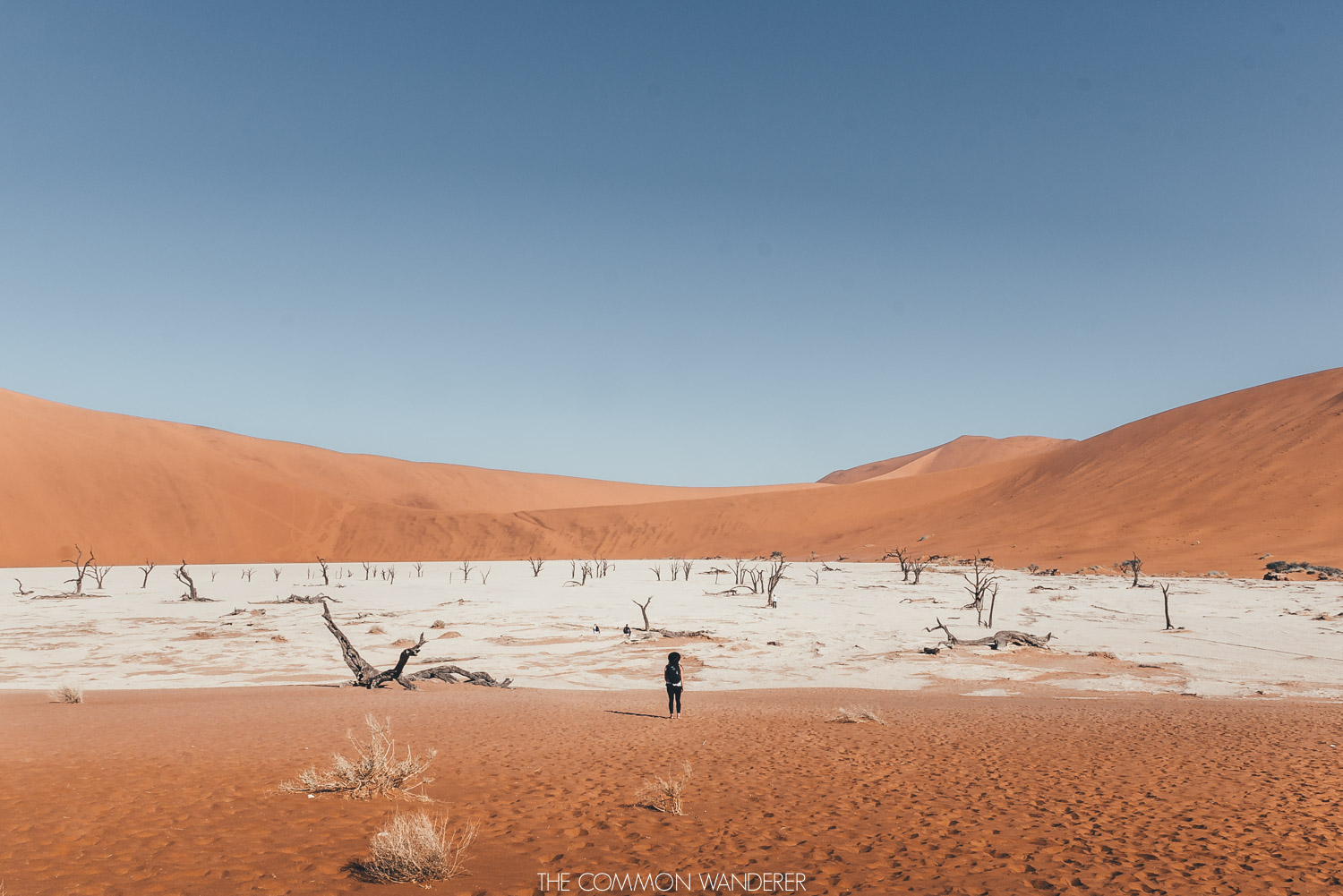32 essential things to know before you visit Namibia
UPDATED 20/2/2020 | Looking for Namibia travel tips before you begin your epic Southern African adventure?
Our Namibia travel tips guide has you covered, including everything from what to see and do, where to stay, how to get around safely, and how to prepare for your trip.
The mountainous red/orange dunes of Sossusvlei, the stark and perilous Skeleton Coast, the moonscapes of Spitzkoppe, the incredible wildlife viewing in Etosha, the deep valleys of Fish River Canyon, the endless starry skies, the blazing African sunsets, the friendly locals, and seriously delicious food.
Yep, Namibia totally blew our minds.
But if we’re honest, we didn’t plan our trip to Namibia very well at all. It was only by chance we met a wonderful local named Hennie, who provided us with the knowledge to navigate Namibia efficiently, safely and enjoyably. His words of wisdom saved us and no doubt led to the incredible time we had in Namibia.
Now it’s our turn to pass on the knowledge we learned. So you can have the best possible trip to Namibia, here are our 32 essential Namibia travel tips to learn before visit this remarkably beautiful country.
NAMIBIA TRAVEL TIPS: 32 ESSENTIAL THINGS TO KNOW BEFORE YOU VISIT
-
#1 SO, WHERE IS NAMIBIA?
For many, the mere mention of Namibia is met with a “where?” response. And we kinda get it - Africa’s a huge continent which, unfortunate as it may be, is still somewhat ignored by the international community.
For those who aren’t sure, Namibia is located on the south-west coast of Africa. It is bordered by South Africa in the south, Angola to the north, Botswana to the east, and Zambia in the northeast.
Mostly arid, the spectacular landscape resembles Mars, with vast expanses of rocky mountains and canyons, vast orange and white sand dunes, and empty savannas, while the rugged Atlantic coastline is one of the most treacherous in the world.
Oh, and despite what Donald Trump may say, it’s pronounced Na-mibia, not Nam-bia (for those of you who don’t know what we’re talking about - watch this!)
-
#2 IS NAMIBIA WORTH VISITING?
The answer to this question is an unequivocal YES.
Namibia is unlike anywhere else on Earth; a place where you’ll feel incredibly small by the magnitude of your surroundings and in complete awe of Mother Nature's finest achievements.
Driving in the middle of the Namib desert, dead mountains and sand dunes surrounding us, having not seen any form of life for hours, we’d never felt more insignificant. To be honest, it was the most exhilarating feeling we’ve had on our travels. And that’s Namibia’s appeal.
With the violent Atlantic Ocean to one side, and the world's oldest desert on the other, Namibia is a seriously rugged destination. It’s home to natural wonders such as deep Fish River Canyon, the towering sand dunes of Sossusvlei and Swakopmund, the wildlife mecca of Etosha National Park, the glorious mountains of Spitzkoppe, a rich indigenous and colonial history, and thriving adventure activity scene.
And it’s home to some pretty damn good beer.
Namibia is also the perfect country to experience the trials and tribulations of Africa for the first time. It’s safe (mostly), the official language is English, the cost of travel is affordable, it has the big five, and its unique landscapes are some of the most impressive we’ve ever seen.
So, if you’re after one of the great road trip adventures, keen to see the Big Five, or to have an adrenalin kick of epic proportions, Namibia is absolutely worth visiting!
-
#3 WHEN IS THE BEST TIME TO VISIT NAMIBIA
We absolutely recommend visiting Namibia during the driest months on the year - around June, July and August. During this period expect clear sunny days with cooler temperatures (sometimes freezing), especially at night.
We were actually surprised at how cold it was, so take an extra jumper just in case.
The dry season is also the best time for game viewing, especially in the Etosha National Park, as animals concentrate around scarce water sources.
There is also less chance of malaria during this period, especially in the northern areas such as the Caprivi strip, which should be avoided during the wet season in January - February.
If you’re after a completely different Namibian experience, the summer rains from November - April can turn parts of the country green and occasionally bring floods to the desert.
Namibia travel tip | Visit Namibia during June, July or August for the best weather and wildlife experiences
-
#4 THE DISTANCES ARE VAST AND YOU SHOULD TRAVEL NAMIBIA SLOWLY
Travel in Namibia is truly unlike travel anywhere else on earth. Known as the land of endless horizons, the vast distances and epic landscapes of this country will leave you feeling both insanely small and insignificant, and carefree and in absolute awe at every turn.
It's epic in every single way, and a visit here is well worth it.
A little known fact is that Namibia has the second lowest population density in the world after Mongolia, with only 2.2 million inhabitants. It’s immensely vast, yet so completely empty. In fact, on one day, we spent several hours driving through the Namib desert without seeing another living soul - not even an animal.
The isolation has its perks though; we found Namibia to be the perfect place to escape the hustle and bustle of city life, and embrace a quieter way of living.
Make the most of the vastness, and spend at least two weeks exploring the country. If you have the time, a month. That way you don't have to rush from place to place and spend days at a time in the car just to tick places off. You won’t regret, and if we’re honest, the longer you spend exploring Namibia, the less likely it is you’ll want to leave.
READ MORE | Our ultimate 10-day Namibia road trip itinerary
BOOK | Rent your 4x4 via Rentalcars.com, our go-to for car rental globally
-
#5 NAMIBIA IS SAFE(ISH)
Undoubtedly, "is Namibia safe to travel" is the question we're asked most often about our time in the country. Our honest answer, is that Namibia felt like one of the safest countries we've ever visited - until we arrived into Windhoek.
On a Saturday night in the heart of Namibia's capital, we were almost mugged. We won’t go into detail as all's well that ends well, but it was our own stupid fault and a lesson for you all - never let your guard down. Why are we telling you this? Because it’s important we’re transparent with you, but it’s equally important you don’t let our small negative experience dissuade you from visiting.
As a whole, Namibians are incredibly friendly, the country's infrastructure is good, and the level of corruption found here is far less than neighbouring countries. It is, overwhelmingly, a peaceful and welcoming country. However, there are still issues with both poverty and gang violence, which has lead to increased personal and petty crime.
When it comes to travel and safety in Namibia, take the normal precautions you would anywhere, such as never leaving valuables or bags unattended in your car, and being wary of those around you at ATMs.
In some areas, we recommend that you don’t wander alone or catch taxis late at night (particularly after 9pm) as there have been reports of armed muggings and theft of tourist's backpacks.
As always, take these warnings with a grain of salt, and rather than let them sway you from visiting, just keep these Namibia safety tips in mind.
It's also very important to buy travel insurance before you visit Namibia
READ MORE | How to travel safely in southern Africa
BOOK | We recommend booking World Nomads travel insurance
pack for africa | our essential packing list for africa
-
A LITTLE ON NAMIBIA’S HISTORY
-
-
#6 NAMIBIA WAS INHABITED BY KHOISAN FOR MILLENIA, THEN COLONISED IN 1884
Prior to the 19th century, Namibia had been inhabited by the rich and peaceful cultures of the original San, Damara, Herero and Nama for millennia. The most well-known of these groups, the San Khoisan, are also believed to be the oldest original people in the region (of Botswana, Namibia and South Africa), living a nomadic hunter-gatherer life.
Then, as in many other African nations (and to the surprise of local indigenous populations), the 19th century Europeans arrived.
Although Namibia was technically a British territory, it was to be German colonists that landed on the shoreline at Walvis Bay in the 1880s and quickly claimed the area known as 'South West Africa' for Germany (actually Prussia, at the time).
This occupation has made Namibia a totally unique country in the area; much of its architecture is German, there's a german newspaper, and most of the population speaks German as one of their main tongues.
However, like most colonial empires in Africa, brutality was enforced on the indigenous population. From 1904 to 1907, in what's become known as the Herero revolt, the local Herero and the Namaqua tribes took up arms against the colonisers, and resulted in what has been termed ‘the first genocide of the Twentieth Century’.
German government officials ordered the extinction of natives, and devastatingly, half of the Nama population and 80% of the Herero population were wiped out.
In many ways, this was the precursor to the apartheid years that dominated this region in the 20th century.
-
#7 APARTHEID ALSO EXISTED IN NAMIBIA
While apartheid is most commonly associated with South Africa today, it's important to be aware that apartheid also existed in Namibia - which is why, like South Africa, a social divide is still evident today.
In the 1940s, South-West Africa become a de-facto ‘fifth province’ of South Africa, and therefore fell under their awful apartheid regime.
Much like South Africa, black and coloured neighbourhoods were torn down, populations were segregated from each other, and it wasn’t until 1990 that independence was gained and the united nation of Namibia was formed.
-
MONEY MATTERS IN NAMIBIA
-
-
#8 THE NAMIBIAN DOLLAR = THE SOUTH AFRICAN RAND
Namibia, along with South Africa, Lesotho, and Swaziland, are all part of the Common Monetary Area. Therefore, the Namibian Dollar is on 1:1 parity with the South African Rand.
The current exchange rate is 1 USD = 14.1 Namibian Dollars (last updated 7/7/2019)
The South African Rand is widely accepted within Namibia, which is definitely handy if you have leftover change from your travels in South Africa.
While we’re talking money, credit card facilities are available just about everywhere (we paid for a room via credit card in the middle of the desert). However, do still carry an amount of cash with you, just in case.
-
#9 NAMIBIA IS ACTUALLY NOT THAT CHEAP
If you're backpacking Namibia on a budget, it's worth nothing that travelling Namibia isn't as cheap as what you might initially think it would be.
In some instances, we found Namibia to be an affordable destination. Essentials, such as food and drink were inexpensive, and we found accommodation in cities and towns as also quite cheap. Entry into the many National Parks is also very manageable.
However, as you make your way out into the desert, the prices absolutely skyrocket.
We recommend being thrifty in the cities by taking advantage of backpacker accommodation (check Hostelworld for the best budget accommodation options) or AirBnB.
We found that when visiting Sossusvlei, Fish River Canyon, or Etosha, Booking.com had the best deals, so we recommend booking your accommodation through them. Alternatively, stay in the many campsites if you have camping equipment.
From our perspective, we mostly stayed in hotel accommodation during our Namibia road trip as we didn't have a tent or camping equipment. This totally hiked up our daily budget for hotel accommodation, and as camping in Africa is super easy, it's safe to say that if we had our time over we'd definitely choose the cheaper campsites instead!
If you’re planning to self-drive, be warned that fuel prices are expensive.
We spent over N$2,500 (almost $200 USD) on fuel during our 7-day road trip.
BOOK | Rent your 4x4 via Rentalcars.com, our go-to for car rental globally
-
NAMIBIA ATTRACTIONS | WHAT TO SEE AND DO IN NAMIBIA
-
-
#10 THERE IS A HUGE AMOUNT TO SEE AND DO IN NAMIBIA
It may be vast, and distances may be long, but Namibia has an awful lot you absolutely must-see.
Sossusvlei, Fish River Canyon and Kolmanskop are must visit destinations to the south, while the unique and wild coastlines of Swakopmund, Walvis Bay and the Skeleton Coast simply cannot be missed.
Don’t forget Etosha National Park, home to some of the best wildlife viewing opportunities in Africa, and the epic, otherworldly landscapes of Spitzkoppe. And we haven’t even mentioned the abundant plains of the Caprivi Strip yet - one of Africa's most unspoiled safari destinations!
READ MORE | Our top 10 essential things to see and do in Namibia, our guide to Sossusvlei dunes
-
#11 WINDHOEK IS WORTH YOUR TIME
Most travellers will arrive to Windhoek and scurry straight out almost straightaway, and in all honesty, we get why. But despite there not being a whole lot to do in Windhoek, we just can't hate on the city - particularly because Mark's mum was born there!
If you’ve been on the road for a while, Windhoek is a good place to stop, relax, and stock up on all your supplies before hitting the Namibian highways to your next destination.
If you are spending time in Windhoek, we recommend checking out the follow places:
Christuskirche (Christ Church)
The Parliament Gardens
The Old Breweries Craft Market
Visit one of the beer houses (it is little Germany after all)
-
#12 SWAKOPMUND IS EXTREME SPORTS HEAVEN
The violent Atlantic ocean to one side, the towering dunes of the Namib to the other, the colonial town of Swakopmund feels like an outpost time forgot. It’s surprising then, that ‘Swakop’ is actually Africa’s adventure capital.
Those looking for a shot of adrenalin can take their pick from a smorgasbord of activities, including skydiving (Swakop is one of the cheapest places in the world skydive!), sand-boarding, quad-biking and power-kiting.
And at night, make your way to one of the many awesome pubs, notable for their delicious German beer and cuisine.
BOOK NOW | Check out and book Swakopmund’s best adventure tours here
-
#13 NAMIBIA HAS GHOST TOWNS
Kolmanskop, in the far south-west corner of Namibia, was once a thriving diamond mining town. Established in 1908, Kolmanskop was complete with stately homes, a school, hospital, bowling alley and ballroom.
As the price of diamonds began to drop after World War One, and after richer diamonds were found further south, the residents began to leave. By 1954 the town was abandoned.
Now, an eerie ghost town remains, partially reclaimed by the constantly moving sands of the Namib. It’s a seriously cool place to visit and one which is worth the effort of getting there (generally from Luderitz).
You will need a permit to enter the area, which can be organised through one of the tour companies in Lüderitz before you go, or at the gate when you arrive.
There are a few things to keep in mind regarding the Kolmanskop permits:
Standard Kolmanskop permits | are about N$75 per adult (though this may have increased since we were there in 2016), and also includes a free tour. While it is possible to wander around the town yourself, but we'd recommend joining the tour to ensure you don't miss out on discovering any of the town's secrets. Tours depart at 9:30am and 11:00am.
Kids permits | if you're travelling with kids, entrance fees are N$50 for children between 6 and 14.
Photography permits | N$230 per person. This is actually a slightly confusing permit as you can still photograph the site using your standard entry permit. However, the photography permit grants access to Kolmanskop from sunrise until sunset and also includes the free tour at 9:30am. Sadly, our schedule didn't allow for us to stay that long - but if you're a keen photographer we'd totally recommend that you purchase the extended permit, as the shadows and light would be incredible on the buildings during this time.
THE DETAILS
Opening hours | 9:00am - 13:00pm each day
Location | Map of the Kolmanskop area - Kolmanskop is 10kms east of Luderitz on the B4 highway.
Cost | Kolmanskop permits N$85.00 per adult (see details above)
Food and drink | Despite being an abandoned town, you can purchase (good!) food at the Kolmanskop restaurant/museum on site.
-
#14 NAMIBIA IS HOME TO A HUGE DIVERSITY OF WILDLIFE
All this talk of deserts and isolation might have had you thinking that there's no interesting wildlife in Namibia - which is absolutely not the case!
The salt clay pans of the Etosha National Park is home to some of the greatest wildlife diversity in Africa, and the Caprivi Strip is known to be some of its most untouched safari plains.
All the usual suspects are here in Namibia; the big 5 and the little 5, along with a number of desert game we'd never seen before, like the Kudu, Oryx, Gemsbok, and the Damara Dik-Dik.
Then, there's the Cape Cross Seal Colony just outside of HentiesBaai (hold your nose as you approach!) and the huge Flamingo population around Walvis Bay.
If it's diverse and plentiful wildlife you're after, Namibia has exactly what you're after.
travel inspiration: 10 places you absolutely must visit in namibia
-
NAMIBIA TRAVEL TIPS | DRIVING IN NAMIBIA
-
-
#15 NAMIBIA IS THE PERFECT ROAD TRIP DESTINATION
Namibia is vast, which we’re sure you’re now aware of. Because of this, it’s the perfect destination for an epic road trip.
The beauty of road tripping through Namibia is having the freedom to travel at your own pace, and go wherever you want to go. There were so many times we just had to pull over, the scenery too incredible to pass.
The road network is extensive and generally well signposted (apart from the depths of the Skeleton Coast).
If you do decide to road trip, be aware of the large distances between destinations, and plan accordingly.
READ MORE | Our epic 10-day Namibia road trip itinerary
BOOK | Rent your 4x4 via Rentalcars.com, our go-to for car rental globally
-
#16 YOU SHOULD HIRE A 4WD AFRI-CAMPER
If you’re planning on road-tripping through Namibia, you should do it in an off road 4WD Africamper. These converted 4WD ute/truck/tray back beasts are made for the Namibian roads, and can easily handle the sand that will inevitably stand in your path.
If you can’t afford a 4WD camper, we recommend hiring a high clearance mini SUV. We managed to get by just fine in ours, despite a few hairy moments.
That said, make sure you have travel insurance for your road trip in Namibia. Distances are vast, and you're in the desert. Be prepared, be safe, and always travel with insurance for the 'just-in-case-worst-case-scenario' moments.
READ MORE | 20 essential tips for driving in Namibia
BOOK | Rent your 4x4 via Rentalcars.com, our go-to for car rental globally
-
#17 YOU ALWAYS NEED TO BE PREPARED
In Namibia, it’s important to prepare for the worst, and expect the best. After all, you're about to take off an a multi-day journey through an extremely dry and wild desert - being ready for whatever that adventures throws at you is a must.
If you’re heading on a Namibian road trip by yourself, we cannot emphasise enough how important it is to always pack extra supplies including food, water, and warm clothing. To give you an idea, we always had a minimum of 10L of water in the back of our car, and enough food to last us 2-3 days if the need arose.
Some days, you'll be lucky to pass another car on the road. On one stretch of road in the Namib Desert, we passed three cars/trucks with punctured tyres. If you’re self-driving, always carry additional fuel and tyres.
READ MORE | Our comprehensive guide to driving in Namibia (including our top tips!)
-
#18 IS DRIVING IN NAMIBIA DANGEROUS?
For a first-timer, driving in Namibia can be tough; there's a lot to know and be aware of. We’re written a complete guide to driving in Namibia, which will answer all your questions and provide helpful tips to safely navigate your way through the country.
Overall, driving in Namibia isn’t dangerous per-se, however, like anywhere in the world, things can and do happen on the long, empty roads. Concentration and lack of experience driving in certain conditions are the biggest issues for those driving in Namibia for the first time.
Many of Namibia’s attractions are located deep into the desert, which can cause issues for those unprepared. Punctures, becoming bogged, or losing control are the most common issues when driving in Namibia, and all can be helped by following the rules and regulations listed in our driving in Namibia guide.
We believe it's imperative you get travel insurance to cover any potential issues driving in Namibia.
We recommend organising comprehensive travel insurance through World Nomads before you go.
BOOK | World Nomads travel insurance
africa safety: how to travel safely in southern africa
-
GENERAL NAMIBIA TRAVEL TIPS
-
-
#19 ENGLISH AND GERMAN ARE WIDELY SPOKEN
Namibians commonly speak two or three (or more!) languages; English, a native tongue like Oshiwambo (spoken by 49% of the population), and either German or Afrikaans.
In fact, due to the country’s colonial history you’ll hear German pretty regularly around areas like Swakopmund (which looks eerily like a quaint german town), while Afrikaans often functions as the lingua franca between locals.
-
#20 PLAN YOUR TRIP AHEAD OF TIME (AS MUCH AS YOU CAN)
Okay, we’re going to let you in on a little secret.
We didn’t plan our Namibian trip ahead of time, nor book any accommodation, and unfortunately we paid handsomely for it. There was actually one moment in Sossusvlei we thought we’d have to sleep in our car overnight, without anything bar the down jackets on our backs. Thankfully, we didn’t!
Major travel fail.
Our advice is to thoroughly research Namibia and plan your Namibia itinerary ahead of time (you can use our Namibia travel guide to plan all your adventures!).
Work out where you want to visit, how to get around, and where to stay; and then book everything you can before you leave. It's an understatement that mobile service is patchy in desert areas, and there's nothing worse than turning up at your destination after a long drive only to discover that the place is entirely booked up.
Note: Namibia is extremely busy during South African school holiday periods, so keep that in mind when planning your journey.
READ MORE | Our ultimate Namibia travel guide
BOOK | Search for dates, and book accommodation in Namibia here
-
#21 THE FOOD IS SURPRISINGLY GOOD (IF YOU LIKE MEAT)
The fusion of German, South African and traditional African cuisine means the quality of food in Namibia is actually very good.
We had many exceptional meals in far flung outposts such as Aus, Fish River Canyon, and Sesriem. And if you’re a meat eater you’ll be in heaven, with vast selection of game meat available just about anywhere. And the trusty road-trip snacks of biltong and boerewors.
Vegetarians, your food game might be a little harder, but definitely not impossible.
-
#22 YOU CAN DRINK THE TAP WATER
It's important to know that you can drink the tap water in Namibia. Sure, it might taste a little different, but so does London's water (yuck!). If you’re still worried, buy a water filtration system such as this before you leave (and stay away from buy bottled water!).
We should point out that Namibia is a desert country and as such has very limited water resources. Try to be water conscious and conserve wherever you can.
BUY NOW | Reusable water bottle - we use the Grayl water purification bottles, which allow us to fill up from any water source, anywhere in the world (including train taps!).
-
#23 IT GETS COLD IN NAMIBIA SOMETIMES
If you’re visiting Namibia during winter (June - September), expect very pleasant days and freezing cold nights.
There were many mornings we’d wake up and refuse to get out of bed, the temperature outside was so cold. Like, between 0c - 10c overnight kind of cold.
That said, during the day the temperature will still climb to around 24c each day, so peaks and troughs, eh?
-
#24 NOT ALL TRAVELLERS REQUIRE A NAMIBIAN TOURIST VISA
Travellers, rejoice - there is a place where the visa process looks upon you favourably! For many travellers in Namibia, there's actually no need to organise a tourist visa at all if your stay is less than 90 days.
The lucky travellers who can go 'visa-free' here are:
South Africans
Australians
British
Germans
Americans
Canadians
Japanese
For the above, do make sure that you check with the immigration desk that you've been granted the full 90 days duration and that the correct date of entry was stamped on your passport to make sure there are no issues down the track when you're trying to depart.
Those who do require the 90-day tourist visa for Namibia (which can generally be processed within 3 days at your local Namibian Embassy) are:
Greece
China
South Korea
Travellers from Eastern European
As always, make sure you double check your individual country's travel advice prior to arriving in the country for the most up to date visa information.
-
#25 CROSSING BORDERS IN AND OUT OF NAMIBIA
Compared to other southern African countries, we found the process of crossing borders into and out of Namibia seamless.
Be prepared to wait, and have the correct documentation such as your passport and , however you won’t be ‘required’ to pay a bribe, or any other underhanded tactics in Namibia.
A Yellow Fever vaccination certificate, which is commonly needed for many African countries, is only required for travellers 9 months of age and older coming from - or who are in airport transit for more than 12 hours within - a country with risk of Yellow Fever transmission.
Crossing into Namibia from neighbouring countries will cost N$295 (as at 05/12/20109), payable when entering Namibia. As far as we're aware, this needs to be paid in cash, so be prepared. You will also need the applicable documentation including:
Valid passport of the driver
Certified copy of the vehicle registration papers
Letter of authority from the registered owner/hire company
Motor insurance certificate - obtainable at the border free of charge
If coming from South Africa, a ZA sticker
For more information, click here.
CAR RENTAL | Search for your 4x4 on Rentalcars.com here
-
#26 PHOTOGRAPHY IN NAMIBIA
A photography enthusiast? Or just someone who loves and epic ‘gram snap? You’re going to love Namibia.
A place where it’s seemingly impossible to snap a bad photo (check out our best Namibia photos!), Namibia is home to some of the most unique and stunning scenery you'll ever see, from the Mars-like landscapes of Sossusvlei to the barren plains of Etosha National Park, from the rugged and dramatic coastline to the frozen-in-time towns.
For the enthusiasts among you, you’ll definitely need to bring a zoom lens to photograph the epic wildlife, while a wide angle lens will bring the unique landscapes to life.
If possible, bringing a lens with a low aperture, which allows more light to pass through the lens, will yield incredible astro-photography results.
Beyond the essentials, consider brings ND or polarising filters to cut out the extreme glare, or commit to shooting early morning and late afternoon for softer, more attractive light.
Below is the photography gear we used to get all of our shots in Namibia.
The Sony A7RII produces brilliant photos and video
The original photography beast which keeps going strong, the Canon 5D MKIII produces the best colours
The Canon 24-70mm is known as one of the best zoom lenses on the market; it's exceptionally sharp, small and lightweight, which makes it perfect for travel photography
The Canon 70-200mm f4 is our favourite lens, hands down. The image stabilisation works a treat, even on moving trains!
Check out the rest of camera gear here.
If you like our photography, be sure to follow us on Instagram, too.
OUR NAMIBIA PHOTOS | The epic beauty of Namibia in photos
desert dreaming: our ultimate guide to the dunes of sossusvlei
-
RESPONSIBLE TRAVEL TIPS FOR NAMIBIA
-
-
#27 RESPECT THE LOCAL CULTURES IN NAMIBIA
Namibia is home to many tribes, including the famous San and Himba peoples, of which the San are believed to be southern Africa's original inhabitants, while the distinctive coloured ochre face paint and braided hair of the beautiful Himba tribe, which indicates age and marital status, has led to worldwide notoriety.
As a result, many visitors to Namibia wish to visit these tribes and understand first hand the semi-nomadic culture, customs and lifestyle.
This has led to a complex power dynamic and has raised questions about the sustainability and responsibility of such visits.
On one hand, it provides money to communities that otherwise may struggle for forms of income, which in turn raises living standards and allows for further education and medical provisions. Visitors also provide the tribes with the ability to stay within their communities and preserve the rich cultural heritage and traditions.
On the other hand, it can be seen as exploitative to view these peoples and photograph them as if their lives were an exhibit.
We’re on the fence a little, as we can understand the benefits of such tourism and what they can do for communities and cultures, but also see the negative outcomes which may occur.
If you wish to visit the tribes, we recommend doing so as part of an ethical, organised tour, where a portion of the profits goes back into the local communities.
If you do visit one of the remote tribes of Namibia, always ask permission before photographing, and steer clear of photographing young children (if you wouldn’t photography children in your own country, don’t do it here!)
-
#28 A LITTLE ON WILDLIFE AND CONSERVATION IN NAMIBIA
Given that 42% of Namibia’s surface area is under conservation management, it’s clear that Namibia takes conservation very seriously.
Namibia is on of the few countries in the world that addresses the importance of the environment in its constitution, in which article 95 states “The State shall actively promote and maintain the welfare of the people by adopting international policies aimed at the maintenance of ecosystems, essential ecological processes and biological diversity of Namibia, and the utilisation of living natural resources on a sustainable basis for the benefit of all Namibians, both present and future.”
We disagree with hunting of any sort, so please don’t partake in this activity in Namibia, regardless of your beliefs.
When visiting national parks and reserves in Namibia, ensure that you don’t leave any litter – everything you carry in you must carry out. Apart from the obvious environmental damage, litter can be harmful to wildlife.
Although it may not be obvious to the naked eye, life still exists around the desert. When visiting the dunes, just be careful where you go, and try to follow trails and pathways so as not to destroy and plants or wildlife.
And finally, whatever you do, don’t buy any animal souvenirs - they stopped being cool in the 1800s and there’s nothing noble about coming home with an ivory tusk, or lions tooth.
-
#29 WATER SCARCITY IN NAMIBIA
Unsurprisingly, in a country mostly covered by desert, Namibia suffers from extreme water scarcity.
To make matters worse, the country is currently afflicted with one of the worst droughts in history, with officials blaming climate change and a five-year drought ripping through southern Africa for dam levels dipping below 20% nationwide (as of January 2020).
If you’re visiting Namibia, keep this in mind when showering or using the toilet.
When we visited, we showered for less than 2 minutes, once a day, a lived by the motto “if it's yellow, let it mellow. If it's brown, flush it down”.
Although it’s a pain, you should do the same.
-
#30 SAY NO TO PLASTIC IN NAMIBIA
Unfortunately, Namibia isn’t immune to the plastic crisis which has engulfed our planet, despite its vast size and small population.
Avoid contributing to the global plastic crisis (read why plastic is a huge travel problem here) by saying no to plastic and opting for the sustainable option when it comes to your snacks, toiletries, and drinks.
Some of our favourite zero-waste swaps are:
Asking for no straw and using our own reusable metal straws instead
Reusable tote bags
Ordering soft drinks or juice in glass or can version (or going without if it’s not available)
Solid shampoo, bodywash, moisturiser
For the ladies: a menstrual cup
READ | Our ultimate guide on how to reduce your plastic consumption on the road
-
#31 TRAVEL WITH A REUSABLE WATER BOTTLE
If you’ve followed us for a while you know this is probably the #1 thing that frustrates us when we travel.
Repeat after us: modern travellers do not need to buy bottled water.
Particularly when you realise that we humans binge on a million plastic bottles a minute, and they take more than 400 years to break down.
It’s possible to drink the tap water in Namibia, however if you’re worried, purchase a water purification and filtration bottle before your travel.
Our trusty The Grayl GEOPRESS water purification and filtration bottles is the best investment we’ve ever made.
As a result, we haven’t bought bottled water in nearly two years now, and have drank tap water throughout Nepal, India, Sri Lanka, and the Caucasus without being sick once.
BUY | The Grayl GEOPRESS water purification and filtration bottles
-
#32 DON’T FORGET THESE NAMIBIA PACKING ESSENTIALS
Not only is Namibia raw and rugged, its weather is hugely diverse, with climatic differences that many struggle to comprehend (like, freezing nights and blazing deserts days).
If you’re planning to visit Namibia, you’ll need a good range of gear to help you travel safely and comfortably.
From the right clothes, to road tripping essentials, here are our recommendations for Namibia packing essentials.
TENT | When you have your own tent, you have the freedom and flexibility to set up camp just about anywhere in Namibia. Our recommendations are: The budget tent: Eurohike Tamar 2 Man Tent, or the sturdy, splurge tent: The North Face Stormbreak Tent
SLEEPING BAG + SLEEPING BAG LINER | It gets freezing in the night in Namibia, so we recommend bringing a sleeping bag with you such as RAB's range of sleeping bags.
If you're heading out on a planned group tour, you'll generally have a sleeping bag provided to you. Always bring a sleeping bag liner (we use these Sea to Summit silk liners) with you to use with hired sleeping bags.
TRAVEL TOWEL | A microfiber towel is the perfect saviour when your hostel doesn't have towels or you need something to dry off with after a quick dip.
REUSABLE WATER CANTEEN | Reusable water bottle - we use the Grayl water purification bottles, which allow us to fill up from any water source, anywhere in the world (including train taps!).
Or, Water-To-Go is an all-in-one device: a reusable water bottle meets incredibly powerful filter device (designed by NASA!), which removes 99.9% of all nasties from any water source you fill it up at.
Order yours here, and get 15% off with our special code: TCW15
A HEADLAMP | Probably one of the most underrated items in any Africa backpacker's arsenal; the trusty headlamp, will help you navigate your campsite in the dark.
SUNSCREEN | It doesn't take long for that relentless Namibia sun to do some real damage, so don’t forget your sunscreen (minimum SPF 30, but ideally SPF 50). We actually found it pretty hard to track down a quality sunscreen that didn't cost a fortune in these parts, so we'd definitely recommend bringing enough for your whole trip from home.
SUNGLASSES | Your peepers will be staring across safari plains in the blazing midday sun for days on end - protect them from damage with a good pair of polarised sunnies.
FIRST AID KIT | In the wild, vast spaces of Namibia, it really does pay to have a well-stocked medical kit in your possession, like this first-aid kit
POCKET KNIFE | A good pocket knife (we have this one from Victorinox) is an absolute essential for your Namibian travels.
PORTABLE SOLAR CHARGER | Reliable electricity isn't always something you can find on the road in Namibia, so we use the Anker Powerport Solar charger, which also has dual USB ports to charge multiple devices, like a phone and a gopro, at the same time.
TRAVEL CUTLERY | Avoid being stuck in your hostel or on the road without any cutlery to eat with, and carry a bamboo cutlery set (or at least a spork!) in your daypack so you're always prepared for meal time (this is actually our favourite travel essential!).
REUSABLE FOOD CONTAINER | These are super useful in cutting down your plastic consumption when you're taking food away from stalls, as well as storing and/or transporting food you've cooked on your travels. We travel with these collapsible food containers.
A GOOD BOOK / KINDLE | Distances are vast and your travel times between destinations here are often pretty lengthy (especially if you’re not driving!). You'll want to bring a decent book along with you - or a Kindle loaded with all your faves.
travel essentials: our comprehensive Africa packing list
-
NAMIBIA TRAVEL ESSENTIALS | PLAN YOUR TRIP TO NAMIBIA
-
-
HOW TO GET TO NAMIBIA
BY AIR
Most people choose to fly into Hosea Kutako International Airport, about 45min east of the capital, Windhoek. If you're flying from Cape Town, South African Airways operates 3 flights per day, other areas are regular (but obviously not as frequent).
Check Skyscanner for the best Namibia flight deals from wherever you're travelling from.
BY BUS
If you're already in Southern Africa and keen to keep costs to a minimum, the most convenient and easy bus service to Namibia is the Intercape Mainliner.
Services run from Cape Town, Victoria Falls, and Johannesburg. It's trickier to travel from Botswana (a mix of local buses and taxis), but it is also possible to cross the border from Botswana too.
BY CAR
We crossed into Namibia at the Vioolsdrift/Nordoewer land crossing from the northwest of South Africa. You can also cross from South Africa at a number of other points, including: Mata Mata, Rietfontain, Nakop, Onseepkans, Sendelingsdrif, and Alexander Bay (full disclosure: obviously as we haven't crossed these, we can't currently vouch for their ease of access or suitability personally).
Self-drive crossings can also be made easily from Botswana, Zambia, and Angola.
BOOK | Rent your 4x4 via Rentalcars.com, our go-to for car rental globally
-
TOURS AROUND NAMIBIA
If self-driving Namibia isn’t quite your style, or you’re concerned about personal safety, there are also a number of small group adventure tours we’d recommend taking through the country, including:
WONDERS OF NAMIBIA | This 10-day G Adventures tour takes in all the best Namibia highlights, including Sossusvlei and Deadvlei, Fish River Canyon, Swakopmund and Etosha National Park. Prices and availability here
Or, search all G Adventures Namibia group tours here
-
NAMIBIA TRAVEL GUIDES
We used our Lonely Planet Southern Africa guide religiously on this trip and recommend you purchase and read one before travelling.
TRAVEL GUIDES | Buy your Namibia guide book
ROAD MAPS | We absolutely recommend purchasing a Namibia roadmap such as this one
-
PLANNING SOME NAMIBIA TRAVELS SOON?
We have a heap of essential reading before you travel to Namibia:
NAMIBIA TRAVEL GUIDE | Our complete Namibia travel guide - what to see, know and do
THE BEST THINGS TO DO IN NAMIBIA | 10 essential things to do in Namibia
NAMIBIA ROAD TRIP | Our 10 day Namibia road trip itinerary, essential Namibia road trip tips
STUNNING SOSSUSVLEI | Our detailed travel guide to Sossusvlei
NAMIBIA IN PHOTOGRAPHS | The epic beauty of Namibia in photos
PHOTOGRAPHY | Love our photography? Wondering what gear we use to get all of our photos around the world? Click here to view our detailed photography gear guide, as well as our top travel photography tips!
RESPONSIBLE TRAVEL | Responsible travel is important. REALLY IMPORTANT. Learn our top responsible travel tips to help you, your family and friends travel more consciously around the globe
ECO FRIENDLY PACKING ESSENTIALS | Don’t leave home without our favourite eco-friendly travel essentials
We hope these Namibia travel trips come in handy. If you've visited, and have something to add, let us know in the comments below!
LIKE IT? PIN IT!
HEADING TO NAMIBIA? CHECK OUT THESE POSTS!
Some of the links on this things to know about Namibia post are affiliate links.
If you choose to purchase using these links, we receive a small commission at no extra cost to you. Please know that by using these affiliate links, you're directly supporting The Common Wanderer to stay wandering, the running costs of the site, and our ability to provide you with free content to help you on your travels.
That, and you're officially a legend.

